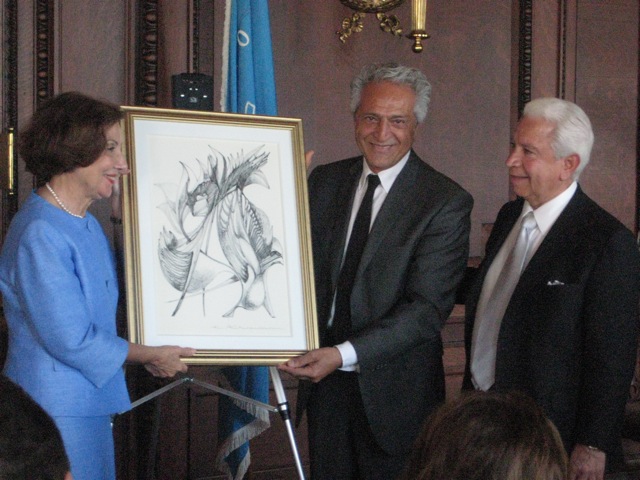Nowruz Commission Presents “Bird Of Freedom” To Library of Congress

Washington, D. C. — On September 8, 2010, in the ornate, historic Members’ Room of the Library of Congress, across the street from the citadel of freedom, the United States Capitol building, liberty’s bell resounded once again – this time in the form of an artist’s personal expression. The “Bird of Freedom”, a drawing by Iranian American artist Kamran Khavarani, was formally presented by the Nowruz Commission to the Library of Congress. Khavarani’s journey from the darkness of tyranny and oppression into the light of freedom of thought and expression, inspired him to create “The Bird of Freedom,” a drawing produced in a time of despair, loneliness and uncertainty in his flight to freedom.
Speaking softly with respect and deep conviction, Khavarani described the moment thirty years ago when he decided to demonstrate through his art and philosophic adherence to the principles of ancient Persian mystics, such as Rumi and Hafez, his devotion to freedom and humanity and their expression in the American experience. Khavarani himself acknowledged that even he was not fully aware until later of the deep symbolism in the work he had created. Unlike the two-legged birds in nature, Khavarani’s impressionist bird of freedom is supported by four legs, representing stability. Under its burgeoning chest resides a pulsating heart as a demonstration of America’s love, lying slightly below a long, narrow rod-like figure in place of a complete body structure, reflecting what Khavarani sees as America’s selflessness. Its feathers do not lie neatly arranged but fly in all directions, boundless and free as the flames of fire are never repeated in exactly the same way. Such is the fire of freedom.
Khavarani’s emotion-laden tribute to freedom was witnessed by the founders and members of the Board of Directors of the Nowruz Commission. Co-founded by the Honorable Bijan R. Kian and His Excellency Erlan Idrissov, the Commission was established in March 2010 with the aim of promoting and preserving time honored and shared traditions of Nowruz, often called the Persian New Year. Chaired by Nasser Kazeminy, the commission is governed by its board of directors composed of its President and CEO, Gissou R. Kian, Anousheh Ansari, Robert Babayi and Kamalludin Abdullaev.
This historic event was also attended by His Excellency Abdujabbor Shirinov, Ambassador of the Republic of Tajikistan to the United States and a representative from the office of The Honorable Congressman Ed Royce of California. Dr. Mary Jane Deeb, Chief of the Middle East and Africa Division of the Library of Congress, accepted the gift on behalf of The Honorable James Billington, the Librarian of Congress.
Reflecting on the mission of the Nowruz Commission, Kazeminy evoked the ancient legend of Kaveh, a humble blacksmith, “who raised the flag of freedom to overcome the dark clouds of tyranny and evil and let the light of freedom shine over the lives of the people…And still, the peoples of many backgrounds, Persians, Afghans, Tajiks, Kazakhs, Azeris, Kurds, Baluchis, Kyrgyz, Uzbeks, some Turks, some Iraqis, some in Ukraine, some in Russia, some in India and other countries continue to celebrate the victory of good over evil.”
When speaking about his love of liberty and America and his hopes for the freedom of all mankind in Iran and around the world, Khavarani smiled and said he agreed with the sentiments of Benjamin Franklin – like Jefferson, an architect of American freedom – who said: “Where there is liberty, there is my country.”
The Library of Congress was founded in 1800 by an act of Congress and later expanded by the purchase of the extensive library of Thomas Jefferson, in whose spirit the Nowruz Commission chose to present Khavarani’s gift of art and love to the American people. On March 20, 2010, California Congressman Ed Royce memorialized in the Congressional Record an account of this event as a permanent part of America’s history.
Please click here to view pictures from this historic event.
Comments are closed